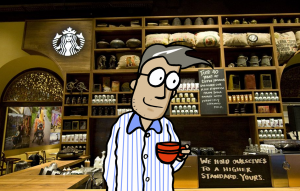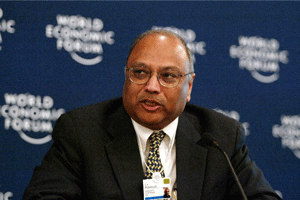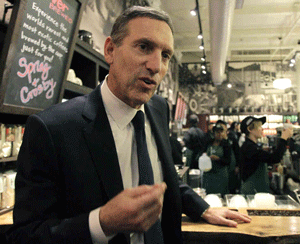There was a time when global brand owners thought all that mattered was their own brand. Coca-Cola led the way in showing how powerful the monolithic brand of its eponymous carbonated drink can be around the world. And of course the same could also be said of other great global brands like McDonalds, KFC, Levis and Microsoft.
However, the assumptions about power of brands and the way they need to be built in emerging markets are being turned on their head.
 Let’s take the humble cup of coffee and what US-giant Starbucks is doing in India right now to get Indian consumers to drink more coffee rather than just tea. The economic case for wanting to do this is highly compelling of course.
Let’s take the humble cup of coffee and what US-giant Starbucks is doing in India right now to get Indian consumers to drink more coffee rather than just tea. The economic case for wanting to do this is highly compelling of course.
In a recent special report, The Super-Cycle lives: EM growth is key, Standard Chartered Bank projects that India’s economic growth could average 6.9 per cent a year 2020-30, compared with 6.3 per cent a year 2014-20.
If achieved, that would treble average real income per head to close to $3,400 by 2030. And at that level, demand for consumer goods and services will blast-off, fuelling industrial supply and raising living standards right across India’s projected 1.3bn population.
But Starbucks isn’t waiting another six years before it makes its move. It’s doing it right now.
“We hope to have thousands of stores in India. I look forward to a day in the not-too-distant future when India takes its place alongside China as one of our two largest markets outside North America. But we know getting there won’t be easy,” remarks Howard Schultz, chairman, president and CEO of Starbucks Coffee Company.
 While the vast majority of Indian consumers today may be relatively poor and represent what Professor CK Prahalad termed the ‘Bottom of the Pyramid’ (BOP) they also represent a highly valuable customer segment for Starbucks. These same consumers are living in a society that’s growing faster than at any other time in its history and with real incomes set to double in the next six years Starbucks has its sights on them.
While the vast majority of Indian consumers today may be relatively poor and represent what Professor CK Prahalad termed the ‘Bottom of the Pyramid’ (BOP) they also represent a highly valuable customer segment for Starbucks. These same consumers are living in a society that’s growing faster than at any other time in its history and with real incomes set to double in the next six years Starbucks has its sights on them.
But Starbucks isn’t the first to have logged this trend. India has witnessed a lot of efforts from global brand owners to roll out products that are affordable for low-income consumers. For example, prices have been lowered by reducing the performance of products and it had been assumed this combination would work.
But many companies found that not creating a product that specifically meets the needs and requirements of the BOP customer segment or has been adapted in some way to save money will simply result in customer rejection.
 For example, in 1994, Kellogg’s entered the breakfast food market on the assumption that it’s ubiquitous Corn Flakes brand would do as well in India as it had in other markets, such as Europe and the US. The problem with this assumption was that Kellogg’s expected Indian consumers to enjoy the product by pouring cold, fresh milk over it. The trouble is that because of sterilisation and food hygiene concerns at that time, Indian consumers tended to boil their milk!
For example, in 1994, Kellogg’s entered the breakfast food market on the assumption that it’s ubiquitous Corn Flakes brand would do as well in India as it had in other markets, such as Europe and the US. The problem with this assumption was that Kellogg’s expected Indian consumers to enjoy the product by pouring cold, fresh milk over it. The trouble is that because of sterilisation and food hygiene concerns at that time, Indian consumers tended to boil their milk!
The product tasted and looked terrible – so no surprise Kellogg’s had to go back to the drawing board. Also, Indians eat a variety of foods at breakfast (including tasty Indian scrambled eggs known as akoori!). Kellogg’s diversified into other breakfast foods but failed to capture any significant share of the breakfast food market.
Instead, enlightened global brand owners now seek to leverage the power of their brands in emerging consumer markets such as India by providing products and services at an acceptable level of quality and performance and at affordable prices through real innovation of either the product or business system deployed.
Starbucks is an excellent example of this and why it’s set to grow its market share in India over the next six years and beyond. And it’s going to achieve this through collaboration.
“Key to our success has been our partnership with the Tata Group. We announced our joint venture with Tata in January 2012. Ten months later, the Indian government loosened restrictions on foreign investment in the retail industry. From a legal standpoint, we could have tried to set up shop in India on our own. But I can’t imagine bringing Starbucks to India without the assistance we’ve received from Tata.
 “They helped us find great locations for our stores. They helped with store design and in getting the food menu right, from tandoori paneer rolls and cardamom-flavored croissants! They helped us overcome the many logistical and infrastructure obstacles to make sure everything on our India menu is fresh. They also helped with recruiting, which is crucial for us because no matter how big we get, the essence of Starbucks is to make that human connection: serving coffee one person, one cup, one neighbourhood at a time,” enthuses Schultz.
“They helped us find great locations for our stores. They helped with store design and in getting the food menu right, from tandoori paneer rolls and cardamom-flavored croissants! They helped us overcome the many logistical and infrastructure obstacles to make sure everything on our India menu is fresh. They also helped with recruiting, which is crucial for us because no matter how big we get, the essence of Starbucks is to make that human connection: serving coffee one person, one cup, one neighbourhood at a time,” enthuses Schultz.
The other unique aspect of Starbucks collaboration with Tata in India is the ability to source and roast coffee beans locally.
“India is the only major market in the world where we can do that, and it’s only because of our relationship with Tata, which is the largest coffee-estate owner in Asia. They not only own farm but also operate their own roasting facilities. We were able to work with them to develop an India-only espresso roast, designed specifically for India, that’s every bit as good as the espresso we serve all over the world,” adds Schultz.
What Starbucks understands perhaps better than many of its global peers is the transition that BOP consumers will start to make from being ‘pre-liberalisation poor’ to ‘post-liberalisation poor’ in the emerging Indian economy that’s set to become the third biggest in the world by 2050.
|
FROM (Pre-liberalisation poor) |
To (Post-liberalisation poor) |
| Settle for less | Stretch for more (Jugaad innovation) |
| Reluctance, avoidance | Seeking experience |
| Abstemiousness (‘not for us’) | Affordable indulgence |
| Destiny-driven, resigned to fate | Struggling and aspiring for a better life |
| Simple needs | State-of-the-art needs too! |
These BOP consumers are now a generation that can be more confident about the future and aspire for a better life, where life isn’t a condition to be endured but to be experienced and enjoyed!
Starbucks has taken such a philosophy to heart and has developed a product that required it to do things differently by creating a unique coffee blend that isn’t roasted by its team – something it had never done before in any market.
“It was a real test of our trust in our new partner because it required us to share with Tata some of the roasting secrets we’ve perfected over four decades and guarded very closely. But the result has been well worth it. In the process, we learned that not everything needs to be invented in Seattle and that with the right partner, we can collaborate and co-author, as long as there is a foundation of trust,” observes Schultz.
As the Starbucks experience demonstrates, brands must redefine what they understand by being global. Out of every 100 people in the world of the future, at least 75 percent will be in Asia and most of them in India and China. One-third will be illiterate; perhaps one-fifth will have a college-education and about a quarter will be developed-market consumers from Europe and the US.
Between now and 2025, about 95 percent of the increase in global population will be in emerging markets and their increase in consumption will be greater than that of the traditional developed markets such as the US and Europe.
The inescapable conclusion is that the centre of gravity of what constitutes ‘global’ has been turned on its head and brand owners must now pursue new solutions that are based on collaboration rather than simply transplant strategies from other markets in order to reach BOP customer segments.














Recent Comments